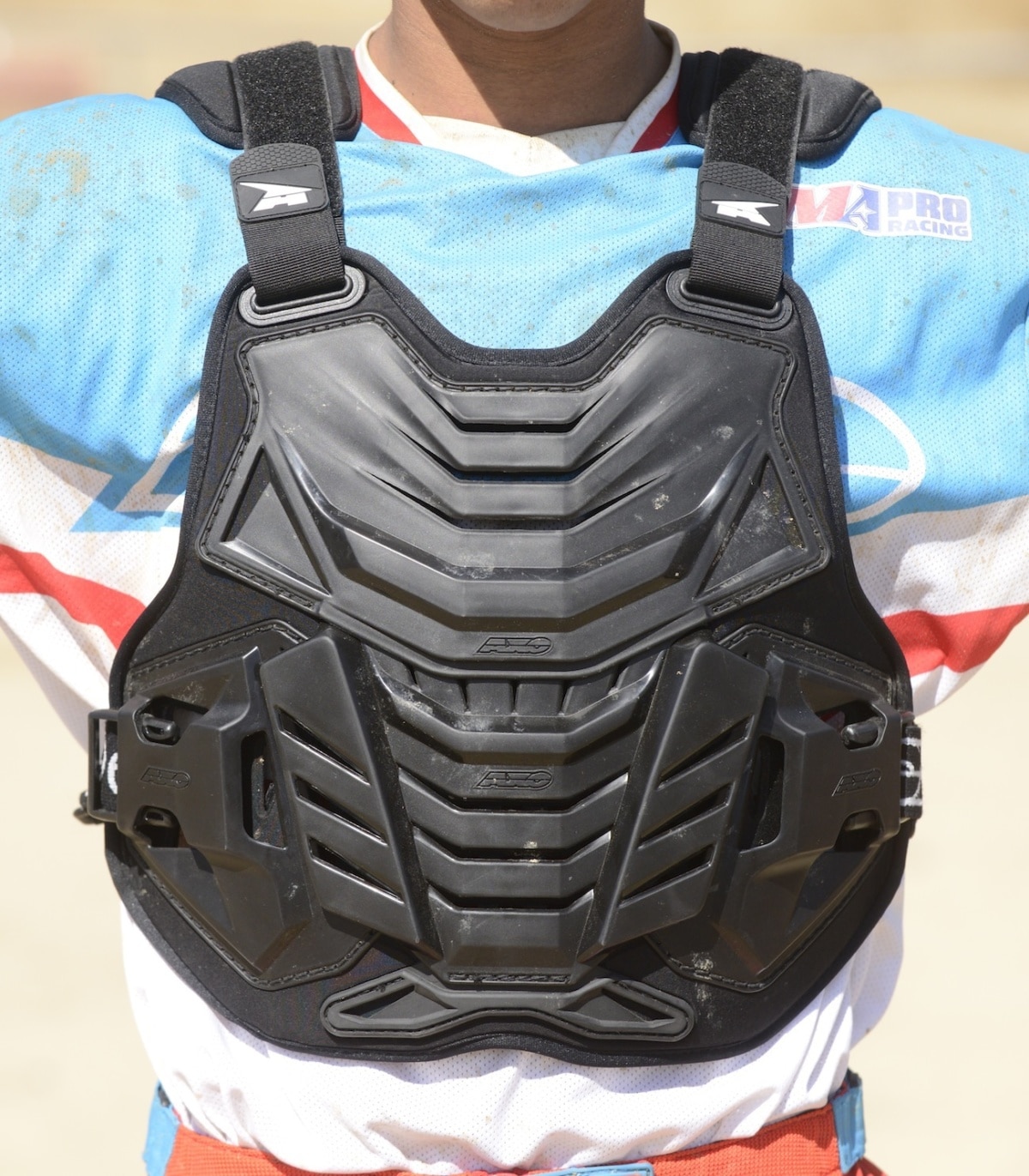MXA TEAM TESTED: AXO PENTAGON MORPHO CHEST PROTECTOR
 WHAT IS IT? Back in the 1980s every rider wore a chest protector, save for AMA Pros. It was a strange juxtaposition between the wearers and the non-wearers, because the Pros made their livelihood with their fragile bodies, thus you would think that they would be the first to don protective gear. Not so. It was the local racers who armored up. Two decades ago there were all manners of ultra-strong, full-coverage chest protectors that could withstand a rocket-propelled grenade. Then they disappeared from the marketplace. Today, the typical racer wears a simple clamshell plastic guard, sans shoulder or arm guards. Thanks to the manufacturers’ lawyers, modern chest protectors are called “roost guards.” But, there is change in the air. Earlier this year Alpinestars introduced its honeycomb-filled A10 chest protector, and now AXO has resurrected its Pentagon chest protector of old with the release of the Pentagon Morpho. It is designed to take a beating so your body doesn’t have to.
WHAT IS IT? Back in the 1980s every rider wore a chest protector, save for AMA Pros. It was a strange juxtaposition between the wearers and the non-wearers, because the Pros made their livelihood with their fragile bodies, thus you would think that they would be the first to don protective gear. Not so. It was the local racers who armored up. Two decades ago there were all manners of ultra-strong, full-coverage chest protectors that could withstand a rocket-propelled grenade. Then they disappeared from the marketplace. Today, the typical racer wears a simple clamshell plastic guard, sans shoulder or arm guards. Thanks to the manufacturers’ lawyers, modern chest protectors are called “roost guards.” But, there is change in the air. Earlier this year Alpinestars introduced its honeycomb-filled A10 chest protector, and now AXO has resurrected its Pentagon chest protector of old with the release of the Pentagon Morpho. It is designed to take a beating so your body doesn’t have to.
WHAT’S IT COST? $145.00.
CONTACT? (661) 257-0916 or www.axo.com.
WHAT STANDS OUT? Here’s a list of things that stand out with the AXO Pentagon Morpho chest protector.
(1) CE impact ratings. The typical roost guard is graded by Europe’s CE rating system as a “stone shield.” Not the AXO Morpho. Its front chest panel meets the more stringent CE EN-1621-2 protection standards (measured by how much force energy it can absorb). The Morpho is CE rated at EN-1621-2 for the front and back panels and EN-1621-1 for the shoulder guards. These standards are way above the typical CE 14021 stone-shield level. How much higher? Double the force energy of a regular roost guard.
(2) Exoskeleton. What makes the AXO Pentagon Morpho so good at absorbing crash energy is its triple-layer padding system. The outer layer, front and rear, is composed of 3mm-thick plastic shells sewn to 6mm-thick Biofoam inner panels. Sandwiched between the plastic and the Biofoam is a 23mm layer of high-density foam on the back panel and a 14mm high-density layer behind the front panel. The total thickness of extra padding is 30mm on the front panel and 40mm on the back panel. That is a lot of energy-absorbing material between your body and the ground.
(3) Sizing. The AXO Pentagon Morpho chest protector claims to be one size fits all. Oh, how we wish this were true, but, of course, no matter how adjustable the over-the-shoulder and waistband Velcro straps are, the 16-inch-long back panel and 16-inch-wide front panel aren’t going to fit comfortably on smaller riders. If you aren’t small, the Morpho will fit you with no issues.
(4) Added features. The Morpho chest protector comes with cup-style shoulder guards that Velcro on. Virtually every MXA test rider removed the shoulder pieces. AXO sells a Pentagon roost guard (minus the shoulder guards) that uses the same basic plastic shells without the thick triple-layer padding underneath it. It retails for $50 less than the Morpho but is CE 14021 rated instead of the much stronger CE 1621 of the Morpho.
WHAT’S THE SQUAWK? We had two minor quibbles: (1) AXO says that the front and rear plastic panels are divided into four separate flexible pieces to allow for more comfort, but this is only true of the front panel. The padding in the rear panel is too thick to allow for much give and take. (2) It is only available in black, which limits the fashion options of most modern riders. (3) Airflow is limited, as you would imagine with three layers of protection.
MXA RATING: This is a chest protector, not just a roost guard, that is designed to handle those painful body-slam-style crashes that break ribs and turn your torso purple. Most riders who wear an AXO Morpho or Alpinestars A10 are doing so because they already know what that feels like.







Comments are closed.